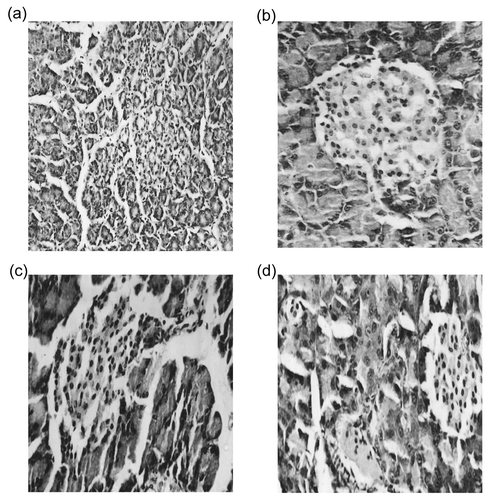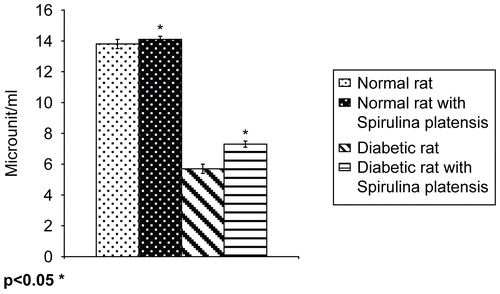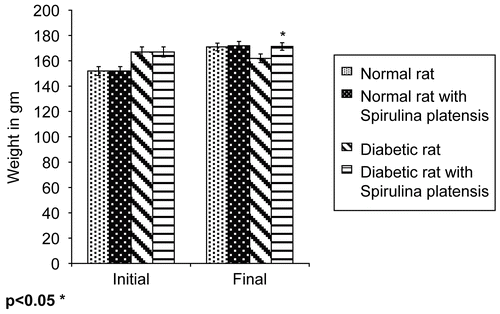Abstract
Marine Spirulina platensis may potentially influence the metabolic process in animal cells, and the effect of marine Spirulina platensis in normal and alloxan-induced diabetic rats was therefore investigated. Normal and diabetic rats (albino Wistar strain) were orally administered marine Spirulina platensis for 30 days and their blood levels of glucose and insulin and body weight changes were determined. Pancreatic histopathology was also noted. Treatment with marine Spirulina platensis caused significant alterations in the content of these indicators and therefore in the antidiabetic capacity of the treated animals compared to control rats.
Introduction
Diabetes mellitus is a complex clinical syndrome characterized by hyperglycemia. The condition has reached epidemic proportions in the present century. A striking feature of diabetes is a shift in fuel usage from carbohydrates to fatCitation1. Diabetes has become a common disease that leads to chronic complications such as neuropathy, nephropathy, vascular disease, and retinopathyCitation2. The incidence of diabetes is predicted to double over the next decade due to changes in lifestyle and the associated obesity in developed countriesCitation3,Citation4. The emergence of the diabetes epidemic in India has added to the economic and health burden of this nation. With over 20 million diabetic subjects, India leads the world in the number of individuals with this disorderCitation2. Non-insulin dependent diabetes mellitus (NIDDM) is considered principally a disease of middle and old age. Overeating, especially when combined with obesity and underactivity, contributes to the development of NIDDMCitation5. Most of the complications of diabetes remain irreversible. This widespread metabolic disease has been reported to be associated with several nutrient deficiencies, some of which have been linked to disorders that occurred secondary to chronic diabetesCitation6.
Several drugs such as biguanides and sulfonylurea have been recommended, and are currently available to reduce hyperglycemia in diabetes mellitus. However, these drugs exhibit side effects. Meanwhile, careful control of blood glucose levels prevents the progression of diabetes to complicationsCitation7. The study and design of antidiabetic drugs have been applied, suggested drugs being benzoic acid derivatives (repaglinide), thiazolidinediones, glycosidase inhibitors, metformin, etc.Citation8. Though several oral hypoglycemic agents are now available, there is difficulty in choosing the appropriate medication for longer periods due to side effects. Hence, patients are willing to afford alternative treatment through traditional folk medicines, e.g. Ayurvedic and Unani systems of medicine.
A large number of plants have been identified in India and elsewhere for their potential hypoglycemic activity. In addition, marine Spirulina platensis, previously called blue-green algae, is recognized for its rich but not yet extensively examined source of pharmacological and structurally interesting secondary metabolites, as well as numerous novel bioactive peptides, macrolides, and glycosidesCitation9. Marine Spirulina platensis consists of free floating filamentous cyanobacteria which occurs in Africa, Asia, and South America. The concentrated nutritional profile of marine Spirulina platensis makes it ideal for those preferring a whole-food supplement to artificial nutrient sources. The present study was therefore undertaken to investigate the antidiabetic effect of marine Spirulina platensis on alloxan-induced diabetes in male albino Wistar rats. Blood glucose, plasma insulin, body weight changes, and histopathological levels were determined using standard methods.
Materials and methods
Male albino Wistar (8–10 weeks old) rats were used for the investigations. The animals were caged under controlled temperature and hygiene conditions, with cycles of 12 hours’ light and dark throughout the experimental period. The animals were provided with access to drinking water ad libitum. Experiments were carried out in accordance with internationally accepted ethical guidelines for the care of laboratory animals. The objective was to investigate the antidiabetic activity of marine Spirulina platensis and its effect on pancreatic beta-cells in male albino Wistar rats. A freshly prepared solution of alloxan (130 mg/kg) in 0.1 M citrate buffer was injected intraperitoneally (i.p.). Following 15 days of i.p. alloxan administration, rats exhibiting moderate diabetes with glycosuria and hyperglycemia (blood glucose > 250 mg/dL) were selected for the experiment. A total of 24 rats were used for the study. Rats were divided into four groups of six animals each: group 1, normal control rats; group 2, diabetic control rats; group 3, normal rats given marine Spirulina platensis (10 mg/kg body weight); group 4, diabetic rats given marine Spirulina platensis (10 mg/kg body weight). Oral administration of marine Spirulina platensis was carried out for 30 consecutive days. At the end of 30 days, the animals were killed by decapitation. Blood was collected in two different containers, one having an anticoagulant such as potassium oxalate and sodium fluoride, for collecting plasma, and the other container without anticoagulant, for collecting serum.
Preparation of the Spirulina platensis extract
The marine Spirulina platensis was kindly provided by the Center of Biotechnology, Bharathidhasan University, Tamil Nadu, India. Marine Spirulina platensis was cultivated by mass culture. Biomass was collected by centrifugation, washed twice with distilled water, and freeze-dried. The freeze-dried biomass was mixed with distilled water to give a 10% (w/v) suspension and heated at 95°C for 30 min. The extract was purified by centrifugation at 10,000 rev/min for 15 min, and stored lyophilyzed until use.
Biochemical profile
Blood glucose in each sample was estimated by the King and Asatoor methodCitation10. Plasma insulin level was determined by radioimmunoassayCitation11. The body weight of each animal was also noted.
Histopathology
For histopathology studies, the rats were anesthetized and their pancreases removed and placed in 10% formaldehyde. Five-micron thickness tissue sections were prepared and stained with hematoxylin and eosin (H&E)Citation12. Stained tissue sections were quantitatively and qualitatively analyzed.
Statistical analysis
All values were expressed as mean ± SEM. Statistical analysis was carried out using SPSS 11 software. The statistical significance of differences between the means was assessed by analysis of variance (ANOVA). A difference at p < 0.05 was considered statistically significant.
Results
Biochemical profile
Treatment of diabetic rats with marine Spirulina platensis caused changes in the levels of glucose and plasma insulin and body weights, compared to control rats. Glucose levels increased and plasma insulin levels decreased significantly in alloxan-diabetic rats. Body weight also seemed to be increased compared to normal rats. However, the administration of marine Spirulina platensis restored these parameters to normal levels.
Effect of marine Spirulina platensis on blood glucose level
Marine Spirulina platensis produced a hypoglycemic effect in alloxan-induced diabetic rats, as evidenced by the determined decrease in blood glucose level (). The blood glucose level of the diabetic rats selected for the study was above 250 mg/dL. In the diabetic rats treated with marine Spirulina platensis, the blood glucose level decreased to 160.45 mg/dL on the final day. Administration of marine Spirulina platensis in normal rats led to a reduction of blood glucose from 87.56 to 74.80 mg/dL.
Effect of marine Spirulina platensis on plasma insulin level
The plasma insulin level was found to be lower in the alloxan-diabetic rats when compared to normal rats. Treatment with marine Spirulina platensis significantly elevated the plasma insulin level in diabetic rats, and to a milder degree in normal rats ().
Effect of marine Spirulina platensis on body weight
The administration of marine Spirulina platensis to alloxan-induced diabetic rats reversed their weight loss and yielded a lesser effect in the case of normal rats. The potential of marine Spirulina platensis to restore body weight loss appears to be due to its antihyperglycemic effect ().
Histopathology
Histological sections of the pancreas were observed to determine the effect of marine Spirulina platensis in normal and diabetic rats. Normal rats showed no architectural changes in pancreas histology (). In most previous studies, diabetes mellitus enhancement has been correlated with an increase in pancreatic toxicity. Pancreases of alloxan-induced diabetic rats, however, revealed diffuse cell necrobiosis. Islets composed mostly of only residual A and B cells showed a reduction in islet size, beta-granules, and granular endoplasmic reticulum. The most common change observed in pancreatic cells was a significant increase in the number of glucagon granules ().
Figure 4. Effect of marine Spirulina platensis on the pancreas of normal and diabetic rats. (a) Control rat pancreas. H&E, × 40. (b) Diabetic rat pancreas. H&E, × 40. (c) Marine Spirulina platensis on normal rat pancreas. H&E, × 40. (d) Marine Spirulina platensis on diabetic rat pancreas. H&E, × 40.

In marine Spirulina platensis-treated normal rats, there was some clumping of chromatin and visualization of pale karyoplasms. Cytoplasmic granulation did not appear abnormal (). Histopathological examination of the pancreatic tissue of diabetic rats after treatment with marine Spirulina platensis showed an increase in beta-cell numbers. The islet of Langerhans size was also larger. This was probably due to regeneration and rejuvenation of beta-cells, leading to increased insulin production and secretion ().
Discussion
The important characteristics of diabetes are polydipsia, polyuria, and polyphagia, weight loss, muscle weakness, and hyperglycemiaCitation13. This work evaluated biochemical parameters such as blood glucose and plasma insulin, body weight changes, and histopathological findings in experimental diabetes caused by alloxan in rats. Streptozotocin complements the alloxan activity to induce diabetes mellitus in ratsCitation14. Nevertheless, alloxan administration has been found to lead to long-lasting diabetes in many animal species. The site at which alloxan interacts with the cell membrane is uncertainCitation15. The rats were fasted for 12 h before and after injection of alloxan; unfed animals were found to be more susceptible to alloxan-induced diabetesCitation16. In this study, it was observed that marine Spirulina platensis when fed to diabetic rats reversed the metabolic changes in alloxan induction. To understand this mechanism, glucose and plasma insulin levels were evaluated following subchronic treatment of rats with marine Spirulina platensis. The experimental findings suggested a significant reduction in blood glucose and elevation of plasma insulin level. The increase in plasma insulin level was indicative of the fact that marine Spirulina platensis enhanced the secretion of insulin from the beta-cells of the islets of Langerhans.
Histopathological examination revealed that marine Spirulina platensis significantly improved the histological architecture of the islets of Langerhans of diabetic rats following treatment. Histopathological study of diabetic control rats showed almost complete destruction of beta-cells, due to the dose of alloxan used in this investigation. An insufficient dose, however, will cause a partial induction of diabetesCitation17. Hence, it is concluded that marine Spirulina platensis brings about antihyperglycemic action through potentiation of pancreatic secretion of insulin from the intact beta-cells of the islets. An effect of marine Spirulina platensis on the regeneration of pancreatic islets was also evidenced by restoration of the cellular architecture of the islets as observed in histopathological studies.
Declaration of interest: The authors report no conflicts of interest.
References
- Andallu B. Control of hyperglycaemia and retardation of cataract by mulberry (Morus indica.L) leaves in streptozotocin diabetic rats. Indian J Exp Biol 2000;40:791–5.
- King H, Aubert RE, Herman WH. Global burden of diabetes. Diabetes Care 1998;21:1414–31.
- Sridhar G R, Rao P V, Ahuja M M S. Epidemiology of diabetes and its complications. In: RSSDI textbook of diabetes mellitus. Hyderabad: Research Society for the study of Diabetes in India; 2002 p. 95–112.
- Deepa R, Aravin K, Mohan V. Diabetes and risk factors for coronary artery disease. Curr Sci 2002;83:1497–505.
- Davidson M B. Effect of Nurse - Directed Diabetes care in a Minority population. Diabetes care 2003; 26: 2281–2287.
- Foster D W. Diabetes mellitus In: Harrison’s Principles of internal medicines, 13th edition, Isselbucher K J, Braunwald E, Wilson J D, Martin J B, Fauci A S, Kasper D L, Eds. McGraw-Hill Inc., New York 1994, p. 1981.
- Hanssen KF, Dahl-Jorgensen K, Lauritzen T, Feldt-Rasmussen B, Brinchmann-Hansen O, Deckert T. Diabetic control and microvascular complications: the near-normoglycemic experience. Diabetologia 1986;29:677–84.
- Kadhe G, Arasan RE. Advances in drug delivery of oral hypoglycaemic agents. Curr Sci 2002;83:1539–43.
- Sundararaman M. Intracellular and extracellular substances in marine Spirulina platensis. PhD Thesis, Bharathidasan University, 1992.
- Asatoor A M, King E J (1954) Biochem. J, 56 xliv, cited by Varley H., Gowenlock. A.H., Bell. M. (1980). Practical clinical Biochemistry, Heinemann Medical Books Ltd. London. P.385–405.
- Yalow RS, Berson SA: Immunoassay of endogenous plasma in man. J Clin Invest 1960;39:1157–75.
- Gomeri G. Aldehyde-fuchsin, a new staining for elastic tissue. Am J Pathol 1950;17:395–406.
- Bragança LAR. Plantas Medicinais Antidiabeticas. Niterói: UFF, 1996:283.
- Szkudelski T. The mechanism of alloxan and streptozotocin action in B cells of the rat pancreas. Physiol Res 2001;50:536–46.
- Luz MMS, Santos CAM, Sato MEO, Arruda AMS. In: Livro de Resumos. XIV Simpósio de Plantas Medicinais do Brasil, Florianopolis. 1996:84.
- Katsumata K, Katsumata K, Katsumata Y. Protective effect of diltiazem hydrochloride on the occurrence of alloxan- or streptozotocin-induced diabetes in rats. Horm Metab Res 1992;24:508–10.
- Lyman DG, Murray EGD. The pathology of the pancreas in experimental diabetes mellitus. Am J Med Sci 1945;210:381–96.


